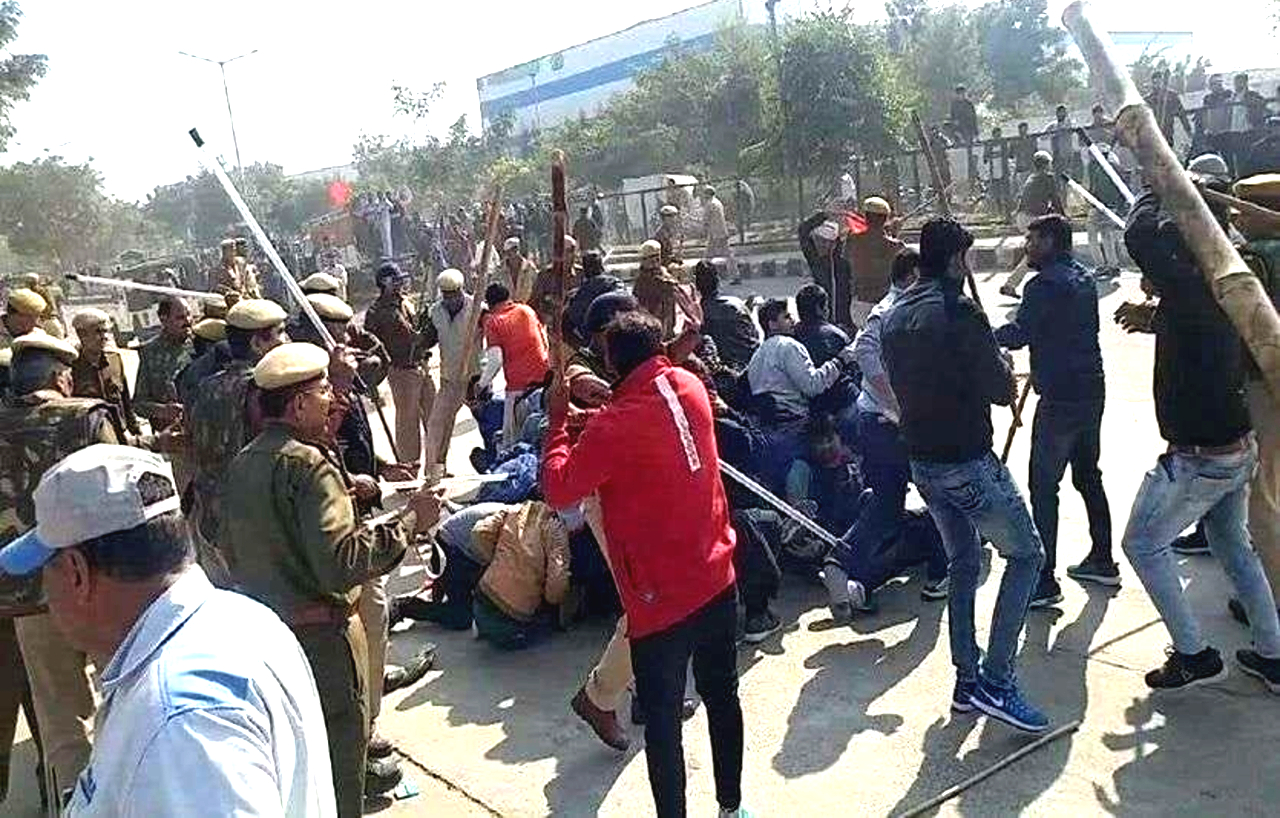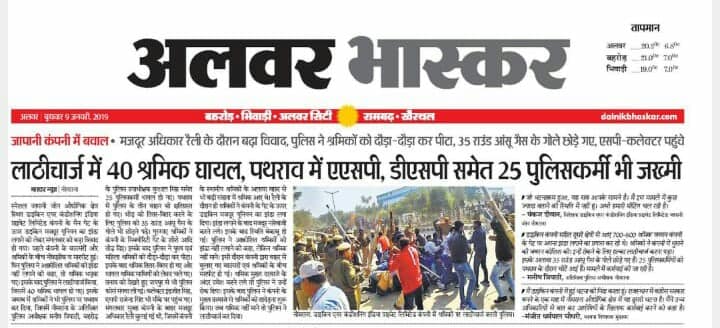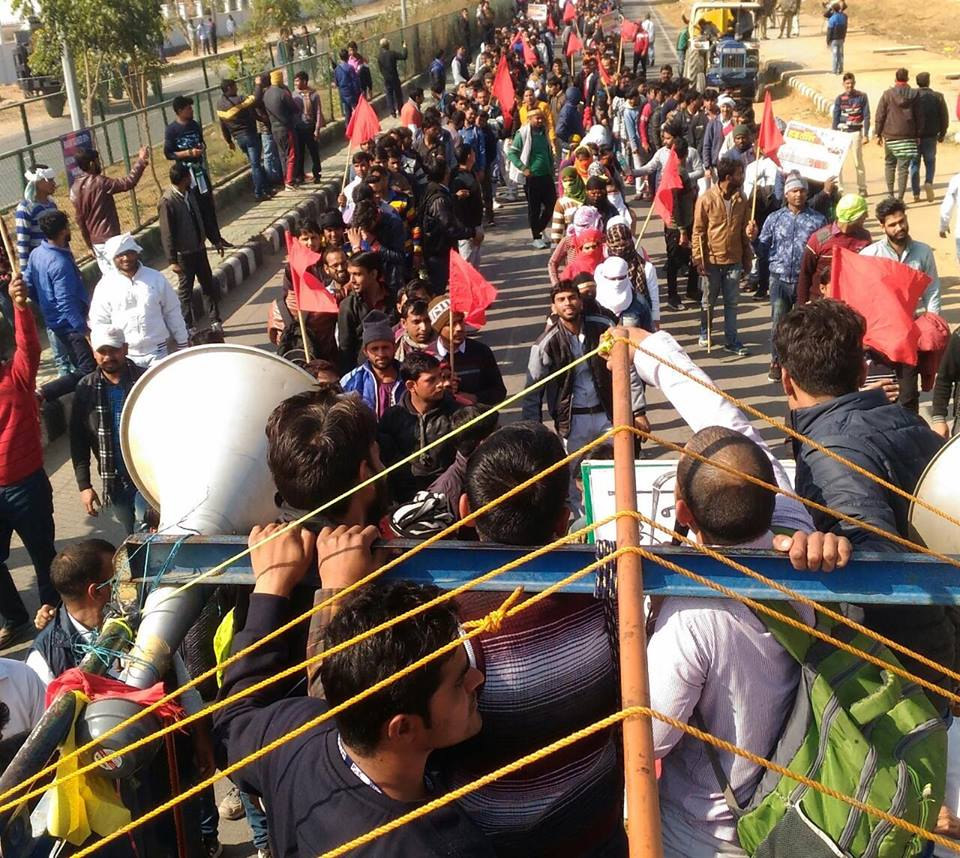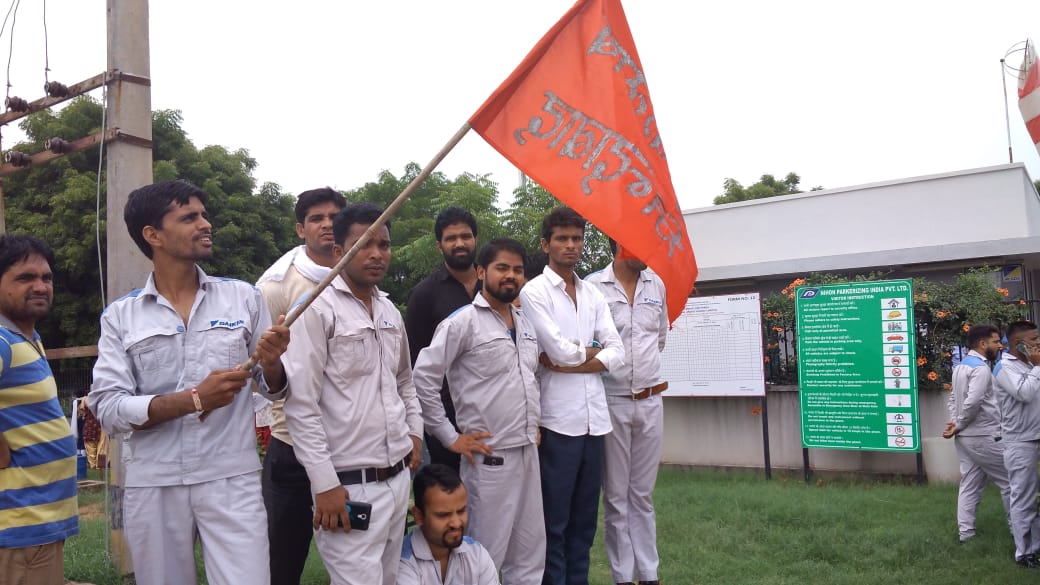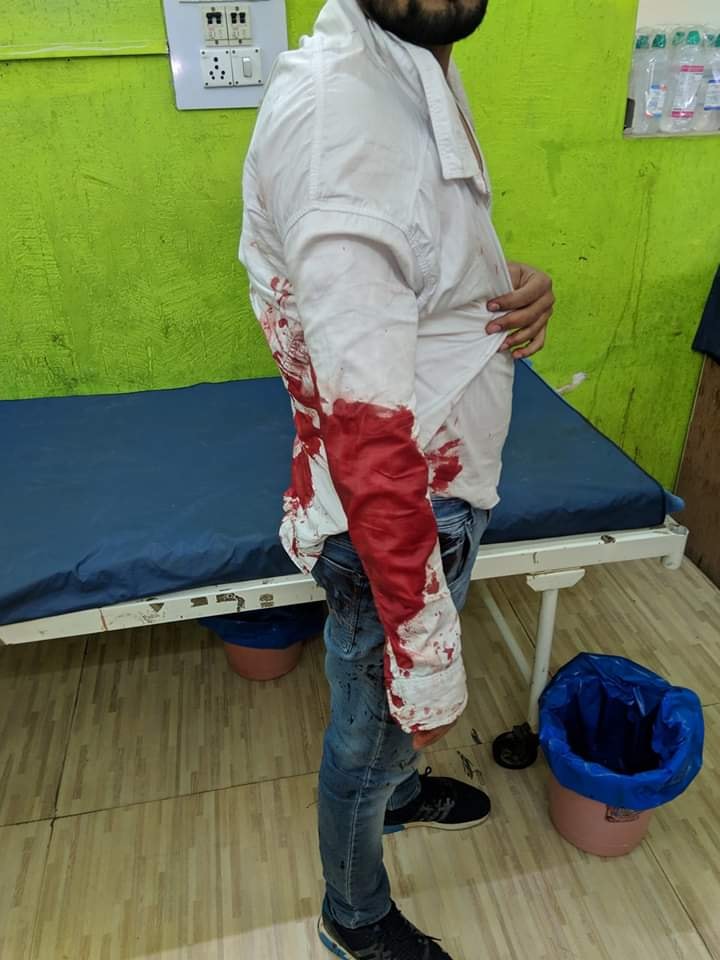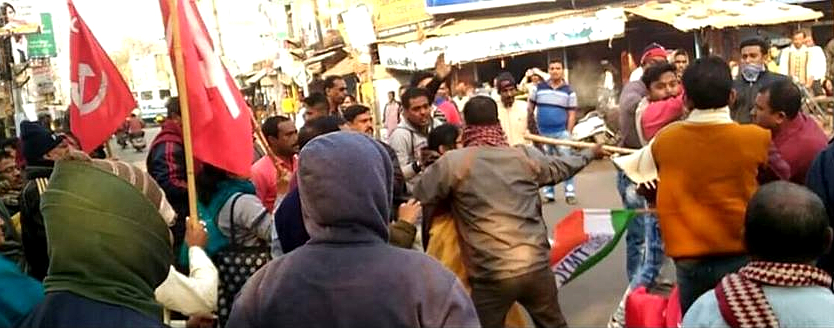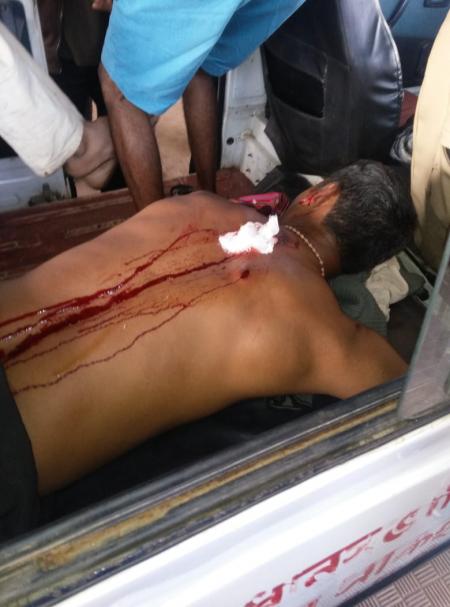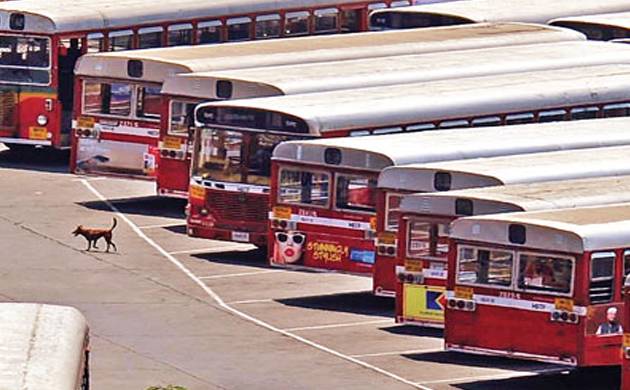When it comes to attack on the working class, all mainstream parties are on the same boat. Be it the saffron-coloured BJP in Maharashtra, the green-coloured Trinamool Congress in West Bengal or the tri-coloured Congress in Rajasthan, all of them are equally brutal and repressive when it comes to the workers’ struggles against capital and their right to unionise. A Groundxero report on brutal attacks on the nationwide workers’ strike on 8th and 9th January.
As the Dalal Street and paid-media celebrated the jump in India’s ‘ease of doing business’ ranking, released by the World Bank in September 2018, the clamor for ‘labour reforms’ – a euphemism for ‘hire and fire’ policy and curtailing the rights of labour – reached a crescendo.
The thrust of neoliberal policies has, of course, been most directly felt by the organized working class, which has seen its numbers, its organizational strength, and its very importance diminish considerably under the impact of such policies. State and capital have used all tools at their disposal to mount a sustained attack on the various strata of working class. From arrests of the workers of BEEU (Bombay Electricity Employees Union) under UAPA, to ban of Mazdoor Sangathan Samiti in Jharkhand which had 22,000 registered members, to the mounting legal battles and state violence on the workers in Tamil Nadu, Haryana, Rajasthan trying to form unions, to the denial of minimum wages, to the contractualisation of permanent jobs – the attack has only intensified in recent years under the present government. As a result, 2018 witnessed some significant battles by the working class.
It was against this backdrop, that 10 central trade unions had announced a two-day nation-wide strike on 8-9 January. Millions of workers irrespective of their union affiliations participated in the strike. The charter of demands included guaranteed minimum wage, universal social security, workers’ status including pay and facilities for the scheme workers, against privatisation of public and government organisations.
While the strike elicited unprecedented response all over the country, capitalists and state machinery tried its best to foil the strike, at many places by use of brutal force. Nowhere was this more evident than in the Neemrana Industrial area in Rajasthan where workers of Daikin Air-conditioning Mazdoor Union took out a rally in support of the All India Strike in the morning of 8 January. It was after years of protracted battle, that the Daikin workers had succeeded in registering their union in September last year.
What happened at Daikin?
On 8 January, on the first day of the strike, the workers of Neemrana, led by Daikin Air Conditioning Mazdoor Union, took out a huge rally of 2000 workers in ‘Japanese Zone’ of the Neemrana industrial area. Apart from the permanent, contract and FTC workers of Daikin, workers from Toyota, Honda, Shyon Ultraware, Nidec and other companies of Neemrana also joined the rally. When the rally reached Daikin company gate at around 2 pm and the workers peacefully hoisted the union flag at the company gate, the police and bouncers hired by the management attacked the workers. In addition to lathi charge, the police also used water cannon, tear gas and rubber bullets on the workers. At least 30 permanent and contract workers, both male and female, including Union President Rukumudeen and Union General Secretary Daulat Ram, were grievously injured, and had to be admitted in nearby hospitals.
Daikin Air Conditioning Mazdoor Union (Registration Number JT/ARTU/28/2018) issued a Statement on the Strike and repression on 8th January 2019, condemning the brutal attack by the police and the company hired goons. They said it was an attempt to crush the 5 year long struggle of Daikin workers and other workers’ struggles in Neemrana industrial area.
14 Daikin workers were arrested later in a midnight raid on the same day, produced in court in Behor and sent to jail custody on 10th January. Bizarrely, none of those who were arrested had their names in the FIR filed by the police. The FIR had baseless & serious charges like attempt to murder (307), rioting, etc, on 17 named and 700 unnamed workers.
Background to the repression on Daikin workers’
In this entire industrial belt known as the Gurgaon-Manesar-Bawal-Tapukera-Neemrana belt which is part of the DMIC (Delhi Mumbai Industrial Corridor) zone, company managements have throughout been averse to workers forming unions. The first attempt by Daikin workers at forming the union was in 2013, with a 2 month strike, but the management brought a court stay order against the formation of the union. A later attempt to form the union was countered by terminating most of the union office bearers and active members. Finally on 29 August 2018 the third attempt to register the union was successful with intervention from the Rajasthan High Court, but management refused to recognize the union or negotiate with the elected office bearers, despite it being an independent, non-affiliated, registered trade union. In retaliation, management transferred 15 workers to various other service locations. Since 2013 about 50 permanent workers have been sacked in the struggle to register the union. The struggle continued and on two occasions when the workers tried to hoist the union flag, it was forcefully removed by bouncers hired by the factory.
The Daikin union however is recognized by workers even in the face of severe repression. Successfully challenging unfair labour practices of the company, the Union enabled 70 fixed term contract (FTC) workers to join the rolls of permanent workers. However, a newly opened ‘Plant B’ has more than 400 women workers, mostly migrants from Chhattisgarh and the North East. Working conditions in this plant are the worst. Many Plant B workers participated in the strikes on January 8th. Inhuman working conditions are widely prevalent in many other companies in the area, and the consolidation of workers across many factories, through organisations such as Neemrana Mazdoor Manch, and then Mazdoor Sangharsh Samiti, Alwar, was perceived as a threat by all these companies and the current repression on workers must be seen in that context.
Fact finding report:
A team of 11 members of various organizations visited the area, in the wake of police repression upon workers participating in the All India Workers’ Strike. The fact finding team spoke to the families of several of these workers as well as to the police.
All the families that spoke to the fact finding team stated the time and place of arrest to be between 11 pm and midnight on January 8, at their residence. As per the law this means that the arrested workers should have been produced before the court on the 9th of January, within 24 hours of arrest. Instead, all the workers were produced before the court around 4 pm on January 10, 2018. This would constitute a serious violation of the law by the police.
The investigating officer in the case, Mr Jai Prakash, Shahjahanpur police station claimed that the workers were arrested from “various places” on January 9th by the police from the Neemrana P.S., and were held there overnight. The Investigating Officer and the policemen from the Neemrana Police Station both refused to give any members of the fact finding team, the workers’ family, or their lawyer, a copy of the FIR which was registered at Neemrana P.S. The Investigating Officer only confirmed that a total of 14 workers had been arrested and charged under sections 147, 148, 149, 307, 332, 336, 353, and 427 of the IPC.
The fact finding team made the following recommendations in its report:
1. The arrests appear prima facie to be arbitrary and backed by no evidence. The workers who were arrested were not even named in the FIR, which mentions 700 “unknown” people – this has clearly been misused as a tactic to pick up any number of workers. These false cases should be withdrawn and all arrested workers must be immediately released.
2. The deployment of bouncers to intimidate workers and their families at home and on the company premises, as well as police to intimidate workers, should be stopped immediately.
3. The use of unfair labour practices, contractualization, oppressive working conditions and retaliatory actions of forced termination or transfer of active union members should be ended.
4. The union should be recognized by management and the democratic and trade union rights of the workers should be recognized.
Following the violence, since 8th January, the Daikin air-conditioning plant has been closed.
In West Bengal’s Didi Raj:
Riding on the back of land-agitations in Singur and Nandigram, Mamata Banerjee, the fire-brand leader from Bengal, dislodged the CPI(M)-led Left Front regime. While in opposition Miss Banerjee had called ‘bandhs’ on numerous occasions. But making a complete U-turn immediately after coming to power, she declared her total opposition to any form of ‘strike’. The left of all varieties have since remained her main target.
Didi’s attitude to workers strike
Even though the workers’ strike was against the Central Government, Mamata Banerjee and her party cadres left no stone unturned to foil the strike in West Bengal. “I do not want to spend a single word on this. In West Bengal, we have taken a stand of not supporting any bandh. Enough is enough. In the last 34 years, they (Left Front) have destroyed the state by calling bandh. There will be no bandh,” Ms Banerjee told reporters at the state secretariat on the eve of the strike.
The state government issued a notification which stated that it has been decided that no Casual leave for absence either in the 1st half of the day or in the second half or for the whole day nor any other leave shall be granted to any employee on the said dates. No leave will also be allowed on the day preceding the two-day strike or following it, a government notification issued on 4th January said.
However, thousands of workers from West Bengal – from the industries, informal sectors and agrarian workers – took part in the strike, despite facing brutal suppression of the Mamata Bannerjee-led Trinamool Congress (TMC) government.
Clashes between supporters of the ruling TMC and opposition CPI(M) were reported from Sodepur, Asansol and Jamuria. The clashes reportedly broke out as CPI(M) workers tried to enforce the strike, after which TMC supporters confronted them. There are reports of police and TMC violence on general strike supporters from various parts of the state. The police picked up many activists and produced them in court with ropes tied around their waist and hands cuffed. On 10th January, more than 30 workers at a chemical factory in the Sinthee area of Greater Calcutta were prevented from entering the factory premises for having supported the strike on 8th and 9th. “We reached the factory gate at 9 in the morning, and found TMC local leaders and workers blocking it. They don’t even work in the factory, but they were stopping us from entering,” alleged one of the workers.
Human rights organizations and various political parties had all along criticized Mamata Banerjee’s attitude towards any ‘opposition and dissent’, particularly by left and democratic forces, as undemocratic and fascist in nature. However, Ms. Banerjee’s diktat to come down heavily on the Government employees who participate in any form of ‘strike’ received a severe jolt on 10th January. The Calcutta High court on last Thursday in a case filed by an employee of the Power Department ruled that the Government can not withhold the pension, promotion, wage increment that is due to an employee even if he or she had participated in a strike or bandh. Further, the High court order stated that there will be a ‘no break’ in the service life of such an employee. This ruling by the court is a legal victory of sorts over the TMC leader’s dictatorial and whimsical rule.
BEST employees strike in Mumbai
Over 33,000 employees of the Brihanmumbai Electric Supply and Transport (BEST) – Mumbai’s public transport undertaking – went on a complete and indefinite strike from 8th January, demanding the merger of the officially loss-making BEST’s budget with the principal budget of the Bombay Municipal Corporation, higher salaries and a new wage agreement that has been pending since April 2016, resumption of appointments and bonus parity with BMC employees. The BEST Kruti Samiti, the umbrella body of all BEST employees’ unions spearheading the strike, has also expressed fears that the administration is bringing in privatization through the back door and making a vital public transport service unaffordable and unsustainable.
Management declares strike ‘illegal’
The BMC and BEST administrations declared the workers’ strike “illegal” and invoked draconian provisions of the Maharashtra Essential Services Maintenance Act (MESMA) against the striking employees, instead of taking steps to respond to their demands. The BEST administration also issued eviction notices to striking BEST employees, and tried to forcibly remove them and their families from their quarters, on the second day of the indefinite strike called by BEST workers’ unions to press for their demands.
Civil society stands in solidarity of striking workers
People’s Union for Civil Liberties Maharashtra in a press release said it is criminal and shameful that the demands of the protesting BEST workers have been met with this kind of penalization and repression from the administration on the one hand and indifference from the State Government on the other. It stated that the workers and their families cannot be penalised in this inhuman manner for exercising their right to protest and to strike, to press for their legitimate demands. It urged the civic administration to withdraw the notices forthwith. The press release also expressed concern at the systematic dismantling of public transport in Mumbai and the destruction of the BEST, which was once Mumbai’s pride.
The Aamchi Mumbai Aamchi BEST (AMAB), an independent forum of citizens for public transport, called upon democratic rights groups, civil society organizations, unions, housing and livelihood rights campaigns to stand in solidarity with the striking workers. The organization, in a statement released on 11 January, said that while the hardships caused by the strike to commuters are real and regrettable, it is beyond doubt that the circumstances that have resulted in the strike are almost entirely of the administration’s own making. “The BMC has done absolutely nothing in addressing the main reason why BEST is in crisis today: its own single-minded dedication to promote an energy guzzling, land intensive, polluting, and exclusive car-centric transport system,” claimed the organisation.
The Maharastra Government has been for long pushing their privatization plans, refusing to subsidize and finance BEST’s operations, cutting down routes, increasing bus fares, and denying workers their dues.
Conclusion
An important feature of the All India Strike was the spontaneous participation of numerous independent unions and workers organizations. Apart from the organized sector, millions of workers from the unorganized sectors like construction, Anganwadi, ASHA and mid-day meal workers, auto-taxi unions actively participated in the nationwide strike. The “new workers” that have been created by neoliberal policies—including call centers and IT hubs, and an exponentially growing service sector too are realizing the need to ‘organise’ and fight ‘collectively’.
But still a huge chasm separates many such workers from the vast masses of the poor, the unemployed, those working for a pittance in an unorganized sector, and members of the rural proletariat. It is a challenge before the working class to devise new ‘weapons’ of class struggle and new ‘forms’ of organizing beyond the traditional political party tied bureaucratic central trade unions.

